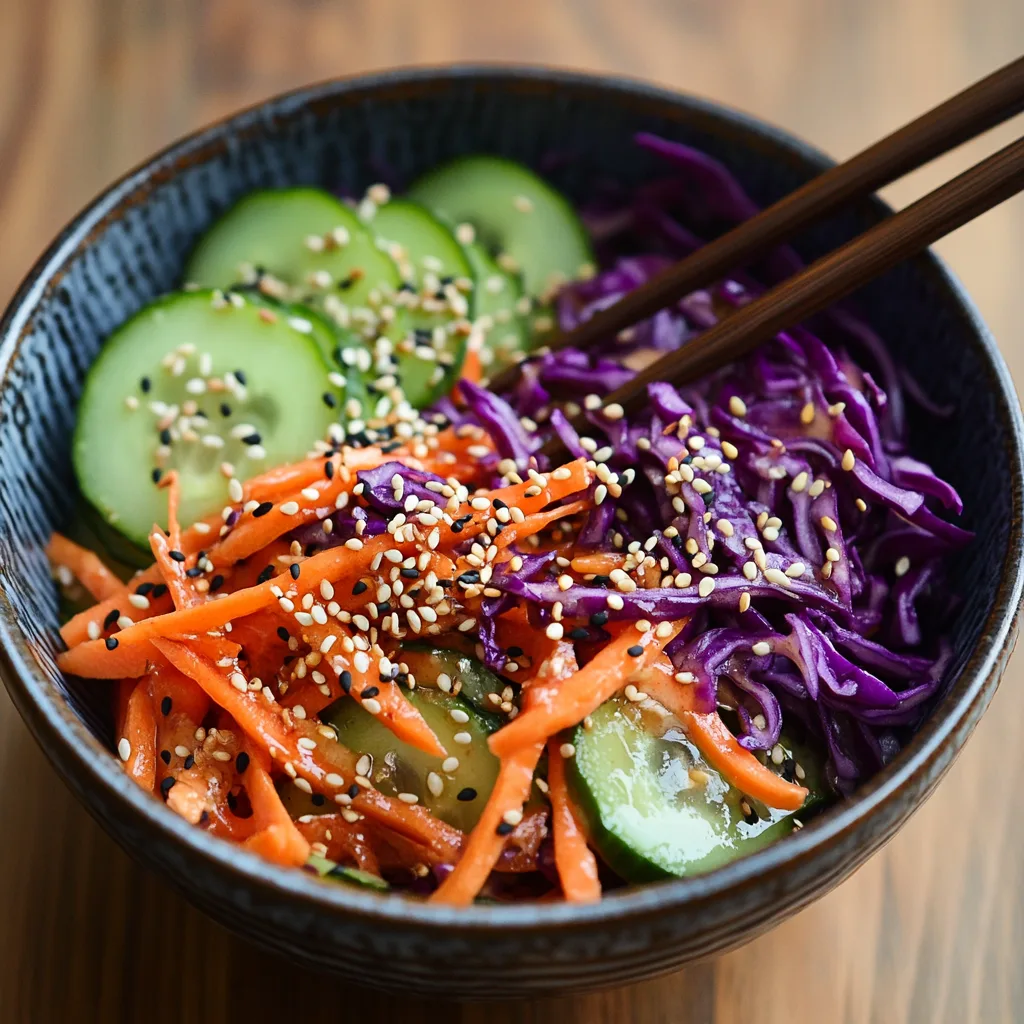When it comes to refreshing, flavorful, and healthy dishes, an Asian salad recipe is hard to beat. These vibrant salads are packed with a medley of fresh vegetables, proteins, and bold, tangy dressings that tantalize the taste buds. Whether you’re a fan of crunchy textures, savory umami flavors, or zesty citrusy tang, there’s an Asian salad out there for everyone. In this article, we’ll search into the essential elements of these delicious dishes, investigate step-by-step recipes, and uncover the cultural and nutritional richness behind them.
Let’s start by understanding what makes Asian salads so unique and why they’ve become beloved around the globe.
Introduction to Asian Salads
What Defines an Asian Salad?
Asian salads are a delightful mix of fresh, crisp vegetables, proteins, and bold dressings, often inspired by the culinary traditions of countries like Thailand, Vietnam, Japan, and Korea. Unlike typical Western salads, they emphasize a balance of flavors—sweet, sour, salty, and spicy. Think crunchy cucumbers paired with a tangy lime-soy dressing or tender beef infused with sesame and ginger.
Popularity and Variations Across Asian Cultures
From the streets of Bangkok to the sushi bars of Tokyo, Asian salads come in countless varieties. Each region adds its own twist. Thai salads often feature spicy and tangy notes, while Japanese salads lean on light, soy-based flavors and seaweed. VIetnamese versions, like green papaya salad, boast refreshing textures and herbal accents.
Why Asian Salads Are a Must-Try for Everyone
Not only are Asian salads easy to prepare, but they’re also incredibly versatile. You can whip up a vegan-friendly dish with tofu and peanuts, or include grilled chicken or shrimp for a hearty meal. Plus, they’re nutrient-packed, helping you eat healthy without sacrificing flavor. Perfect for summer lunches or dinner starters, these salads are a surefire crowd-pleaser.
Ingredients in an Asian Salad
Common Ingredients Used in Asian Salads
Every great Asian salad recipe starts with fresh, high-quality ingredients. The foundation often includes crunchy vegetables like carrots, cucumbers, cabbage, and bell peppers. Herbs play a starring role too—think cilantro, mint, and Thai basil, which add a fragrant burst of flavor. These elements form the backbone of many Asian salads, delivering freshness in every bite.
Other staple ingredients include sesame seeds, crushed peanuts, and crispy wonton strips, which lend texture and variety. dont forget the lime, ginger, and chili—key players in balancing sweet, salty, sour, and spicy flavors that make these salads irresistible.
Fresh Vegetables: Cucumber, Carrots, and More
Crisp veggies are the hallmark of any asian salad recipe. Sliced cucumbers bring a refreshing crunch, while julienned carrots add natural sweetness. Red cabbage or Napa cabbage adds vibrant color and a hearty bite. Many recipes also incorporate unripe fruits like green mango or papaya for a tangy twist.
Protein Options: Chicken, Tofu, Shrimp, and Beef
Protein is a key ingredient in transforming a simple salad into a satisfying meal. Grilled chicken marinated in soy sauce and sesame oil is a common addition, while tofu serves as a popular vegetarian option. Other choices include tender beef strips, pan-seared shrimp, or even poached salmon. The protein options are as diverse as the salads themselves.
Unique Dressings: Soy Sauce, Sesame Oil, and Citrus
What sets Asian salads apart is the dressing. A perfect blend of soy sauce, sesame oil, rice vinegar, and a touch of lime juice creates the signature taste. Add minced garlic, ginger, or a hint of honey to raise the dressing. Peanut sauce and miso-based dressings also make excellent choices.
Step-by-Step Recipe for a Classic Asian Salad
Preparation Time and necessary Tools
Creating a classic Asian salad recipe is simpler than you might think. You’ll need a cutting board, a sharp knife, a mixing bowl, and a whisk for the dressing. Preparation typically takes 15–20 minutes, making it perfect for busy weeknights.
How to Chop and Prep Ingredients
Start by washing and drying your vegetables thoroughly. Thinly slice cucumbers, julienne carrots, and shred red cabbage. For proteins, grill chicken or tofu until golden brown and slice into bite-sized pieces. Herbs like cilantro and mint should be rinsed and roughly chopped.
Creating the Perfect Dressing: A Quick Guide
Whisk together 2 tablespoons of soy sauce, 1 tablespoon of sesame oil, 1 tablespoon of rice vinegar, and the juice of half a lime. Add 1 teaspoon of grated ginger, 1 minced garlic clove, and a pinch of sugar. Taste the dressing and adjust for balance—more lime for acidity, or a bit of honey for sweetness.
Mixing and Assembling the Salad
In a large bowl, combine your chopped vegetables, protein, and herbs. DRizzle the dressing over the top and toss gently to coat every piece evenly. Sprinkle with sesame seeds or crushed peanuts for a finishing touch. Serve immediately to enjoy teh salad’s fresh, bold flavors.
Variations of Asian Salads
Vietnamese Green Papaya Salad
A refreshing staple in Vietnamese cuisine, green papaya salad (gỏi đu đủ) is loved for its crisp texture and bold flavors. Made with shredded unripe papaya, fresh herbs, and roasted peanuts, this dish is tossed in a zesty dressing of lime juice, fish sauce, and chili. The result is a vibrant salad with sweet, sour, and savory notes. To make it vegan, you can substitute fish sauce with soy sauce or tamari. It’s perfect as a light starter or a side dish with grilled meats.
Japanese Cucumber and Wakame Salad
Japanese salads often lean on minimal ingredients with maximum flavor. This cucumber and wakame (seaweed) salad is no exception. Sliced cucumbers are combined with rehydrated wakame, then dressed in rice vinegar, soy sauce, and sesame oil. A sprinkle of toasted sesame seeds adds nuttiness to this light and and healthy dish. This variation is a great side for sushi or grilled fish.
Korean Spicy Kimchi Salad
Kimchi, a Korean staple, is the highlight of this spicy salad. Toss thinly sliced napa cabbage or radish with gochujang (Korean chili paste), rice vinegar, and sesame oil for a fiery kick. The spicy-tangy flavors make it an excellent companion to Korean barbecue or even plain rice. For those who enjoy heat, this salad is a must-try.
Thai Beef Salad
Thai beef salad, or Yam Neua, is an explosion of flavors. Grilled beef slices are tossed with cucumber, cherry tomatoes, onions, and fresh herbs in a dressing of lime juice, fish sauce, and sugar. The balance of tangy and savory flavors is unforgettable. This salad works as both a main dish and a hearty appetizer.
For more recipe inspiration, check out this article on healthy Asian-style meals.
Health Benefits of Asian Salads
Nutritional Benefits of Fresh Ingredients
Asian salads are a powerhouse of nutrition. The fresh vegetables provide essential vitamins, minerals, and fiber, supporting digestion and overall health. Herbs like cilantro and mint contain antioxidants, while lime juice is rich in Vitamin C. These salads often include low-calorie ingredients, making them ideal for a balanced diet.
Why Asian Salads Are Great for Weight Management
The combination of lean proteins and fresh produce makes an Asian salad recipe an excellent choice for those aiming to maintain or lose weight. Ingredients like tofu, grilled chicken, or shrimp provide protein that keeps you full longer. Meanwhile, the absance of heavy dressings or added sugars be sure you stay within your calorie goals.
Boosting Immunity with Herbs and Spices
Asian salads often feature immune-boosting elements like ginger, garlic, and chili peppers. These ingredients have anti-inflammatory and antibacterial properties, promoting overall wellness. Regularly enjoying these salads can be a delicious way to support your immune system naturally.
For more tips on healthy eating, investigate our guide to nutritious recipes for athletes.
Serving Suggestions and Pairings
Best Dishes to Serve with Asian Salads
An Asian salad recipe is versatile enough to complement a variety of dishes. Pair it with stir-fried noodles or a hearty bowl of fried rice for a satisfying meal. If you’re serving it as a starter, follow up with classic Asian main dishes like teriyaki chicken, Thai curry, or miso-glazed salmon. The crisp, fresh flavors of the salad perfectly balance the rich, savory profiles of these dishes.
For a lighter option, Asian salads go wonderfully with simple steamed dumplings or spring rolls. The fresh, tangy flavors of the salad raise these appetizers, creating a harmonious dining experience.
Ideal Beverages: Teas, Wines, and Mocktails
Beverages can increase the enjoyment of an Asian salad recipe. Pair your salad with jasmine tea, green tea, or a lightly sweetened iced matcha for a refreshing accompaniment. For those who enjoy wine, a dry white wine like Sauvignon Blanc complements the salad’s vibrant flavors. If you prefer non-alcoholic options, consider a ginger-lemon mocktail or sparkling water infused with cucumber and mint.
Expert Tips and Tricks for Perfect Results
How to Keep Vegetables Fresh and Crisp
To be sur your Asian salad recipe shines, start with the freshest ingredients. Store vegetables like carrots and cucumbers in cold water before using them to keep them crisp. For leafy greens, pat them dry with a paper towel after rinsing to prevent sogginess. Always assemble the salad just before serving to maintain its texture.
Balancing Sweet, Sour, Salty, and Spicy Flavors
Achieving the right flavor balance is key. When making the dressing, taste and adjust as you go. Too salty? Add a splash of lime juice. Too sour? A touch of honey or sugar can fix it. Always aim for harmony among sweet, sour, salty, and spicy flavors—this is the hallmark of a great Asian salad recipe.
Substituting Ingredients for Customization
Asian salads are incredibly adaptable. If you’re missing an ingredient, don’t worry! Swap fish sauce with soy sauce for a vegan-friendly option, or use apple cider vinegar if you’re out of rice vinegar. Personalize your salad to suit your preferences and dietary needs without compromising its deliciousness.
FAQs About Asian Salad Recipes
What Are the Best Dressings for Asian Salads?
The dressing is the heart of any Asian salad recipe. POpular options include a sesame-soy dressing, Thai peanut sauce, or a tangy lime-fish sauce mix. If you’re looking for something lighter, try a miso-ginger vinaigrette. Each dressing offers a unique flavor profile, so feel free to experiment until yuo find your favorite.
Can I Make an Asian Salad in Advance?
Yes, you can prepare parts of your Asian salad recipe ahead of time. Chop vegetables and store them in an airtight container in the fridge. Keep the dressing separate to prevent the salad from getting soggy. When you’re ready to serve, simply toss everything together and enjoy.
Are Asian Salads Suitable for Vegans?
Absolutely! Most Asian salad recipes are naturally vegan or can be easily adjusted. Use tofu or tempeh as your your protein, and substitute fish sauce with soy sauce or tamari. You’ll still enjoy the bold, refreshing flavors of an Asian salad without any animal products.
How to Store Leftovers Properly?
To keep leftovers fresh, store the salad and dressing separately in the fridge. Vegetables should be kept in an airtight container and eaten within a day or two. This helps maintain their crunch and be sure your salad still tastes great.
Conclusion and Final Thoughts
Asian salads are a delightful blend of freshness, flavor, and nutrition. form simple cucumber-based salads to more complex creations like Thai beef salad, there’s an Asian salad recipe for everyone. These salads are versatile, easy to customize, and packed with health benefits. Whether you’re preparing a quick meal for yourself or serving guests, Asian salads never fail to impress.
So why wait? Grab you’re ingredients, whip up a zesty dressing, and start exploring the world of Asian salads today. dont forget to share your creations and inspire others to embrace these vibrant, flavorful dishes.


